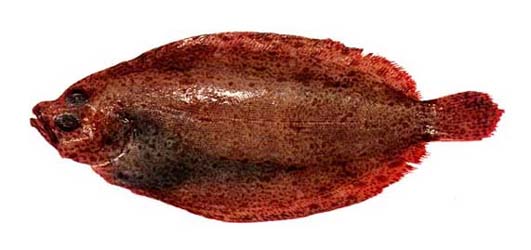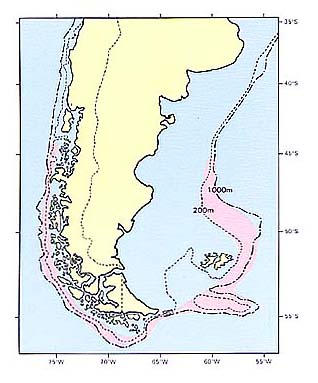ダルマガレイ科
- HOME
- デジタル図鑑
- パタゴニア海域の重要水族
- 硬骨魚綱 カレイ目
- ダルマガレイ科
ダルマガレイ科(Bothidae)

126 ヒメテナシビラメ(Hime-tenashibirame)
Mancopsetta maculata (Günther, 1880)
Lenguado pintado(Ch.)
特 徴:
背鰭112〜129軟条,臀鰭91〜104軟条,腹鰭7(有眼側),5(無眼側),鰓耙数5〜7+1+11〜14=17〜22,鰓条骨数7,側線鱗数114〜131。脊椎骨数14〜15+38〜40=53〜54。体長に対する頭長の割合(%)は:26.4〜28.0,眼径は4.1〜5.6,骨質眼窩径は6.4〜8.5,体高は39.4〜45.3,吻長は5.7〜6.3,両眼間隔は0.8〜1.4,上顎長は9.2〜10.1,尾柄高は9.3〜10.3,腹鰭長は3.6〜5.5(有眼側),4.0〜4.6(無眼側),背鰭高は7.4〜8.3,臀鰭高は7.1〜8.7。体は長楕円形で,体高は頭長のほぼ1.5倍,頭の背縁は上眼の前方で大きくくぼむ。吻は幾分前方に突出するが,眼径より短い。下顎は上顎下にほぼおさまる。下眼は上眼より多少前位。両眼間隔域は狭く,骨質の隆起縁がある。上顎の後端は眼の中央下に達する。両顎の歯は小円錐状歯で内側にやや少し湾曲する。鱗は小櫛鱗で,やや脱落し易い。吻,両顎および両眼間隔域も被鱗する。背鰭は上眼の前方に発する。臀鰭起部は鰓蓋骨後縁下に位置する。胸鰭はない。有眼側の腹鰭は峡部に発し,中央で有眼側に少しねじれる。尾鰭後縁は凸形を呈する。側線は胸部上方でわずかに湾曲するが,以後直走する。尾柄部はやや高い。有眼側は全体に淡褐色ないしは緑褐色を帯び,体側,頭部,背鰭,臀鰭,尾鰭に褐色の斑点が散在する。無眼側は乳白色で,時に褐色斑が現われることがあり,両側有色現象を呈することがある。体長約30 cmに達する。
分 布:
プリンスエドワード島近海,インド洋南部海域,フォークランド島近海,南大西洋に分布する。開洋丸の調査で,パタゴニアのバードウッド堆,フォークランド諸島周辺海域およびその北方の陸棚縁辺からかなりの深み(860 m)にまで生息することが明らかになった(水産庁,1971b)。今回,第72あけぼの丸の調査でチリ パタゴニアへの本種の分布も確認された。ケルゲレン島付近からも知られている。
備 考:
肉質はやや軟らかいし,多獲されないので重要魚種にはなり得ない。
(中村 泉)
Material examined:
10 from Argentina (176.6-270.5 mm SL), 1 from Chile (225.0 mm SL), FAKU 42726, 42730, 42731, 42734, 42743, 42744, 42745, 42747; AP 681, 682, CP 601.
Description:
D 112-129; A 91-104; P27 (ocular side), 5 (blind side); GR 5-7+1+11-14=17-22; BR 7; LLS 114-131.
HL 26.4-28.0% of SL; ED 4.1-5.6; BO 6.4-8.5; BD 39.4-45.3; SN 5.7-6.3; IO 0.8-1.4; UJ 9.2-10.1; CP 9.3-10.3; P2L 3.6-5.5 (ocular side), 4.0-4.6 (blind side); DH 7.4-8.3; AH 7.1-8.7.
Body oval, elongate and extremely depressed, depth of body 2.2-2.7 times in SL. Head moderate in size, 3.7-3.9 times in SL. Upper profile of head slightly notched anterior to eye. Eyes on left side, upper parts of both eye-balls densely scaled by fine scales. Snout shorter than fleshy orbit. Lower eye slightly anterior to upper eye. Mouth small, upper jaw length 2.2-2.4 times in head, posterior margin of upper jaw extending slightly posterior to anterior margin of eye. Fine conical teeth in bands on both jaws, teeth on upper jaw larger than teeth on lower jaw on ocular side. Teeth on ocular side larger than teeth on blind side. No teeth on vomer or palatines. Nostrils on ocular side small, situated closely each other, anterior nostril round with a long flap posteriorly and posterior nostril round with a short flap posteriorly. Nostrils on blind side also small, situated near to dorsal margin of head, anterior nostril round with a short flap and posterior nostril round without a flap. Gill-rakers short. Interorbital region very narrow. Dorsal fin originating just anterior to upper eye. No pectoral fins. Pelvic fin on ocular side extremely larger than on blind side. Scales of body small, ctenoid on both sides. All unpaired fins also covered with fine ctenoid scales. Lateral line equally developed on both sides of body, nearly straight without supratemporal branch. Anus situated on median line, just anterior to anal fin between pelvic fins. Caudal fin found.
Distribution:
Both Chilean and Argentine Patagonia, also kown from the Subantarctic Sea.
Remarks:
Kotlyar (1978) recognized the subspecies, M. m. antarctica from the Antarctic Sea and M. m. maculata from the Patagonian Falkland Region.
(Izumi NAKAMURA)

Distribution of Mancopsetta maculata in Patagonia.

Head. Dorsal fin origin arrowed.